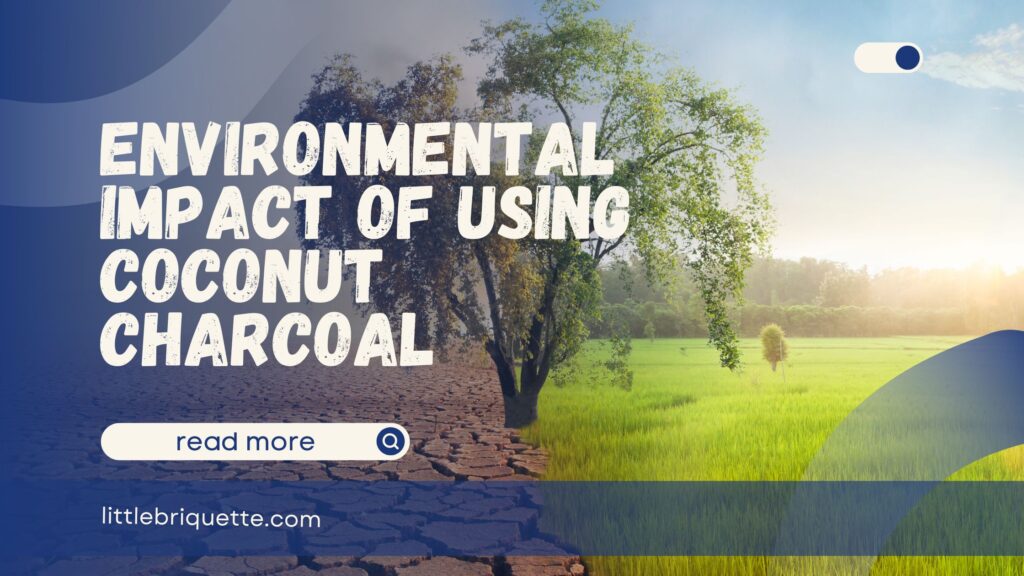Coconut charcoal is an alternative energy source that can replace fossil fuels and is becoming increasingly popular due to its positive environmental impact. The environmental impact of using coconut charcoal has a sustainable value because it utilizes coconut shell waste as the primary raw material, which is then processed through carbonization into charcoal. This alternative fuel helps reduce the amount of unused coconut shell waste that could otherwise pollute water and air.
Environmental Impact of Using Coconut Charcoal
Coconut charcoal is a fuel produced by burning coconut shells at high temperatures in conditions with limited oxygen. This process yields a solid, black, and porous material known as charcoal. This fuel product is recognized for its environmentally friendly nature compared to charcoal from other sources, and it is highly efficient as a fuel source.
However, coconut charcoal has both positive and negative environmental impacts. Below are the environmental impacts of using coconut charcoal as an alternative fuel:
Positive Environmental Impacts

- Reduction in Carbon Emissions: Coconut charcoal is a renewable energy source that is more environmentally friendly than fossil fuels because it reduces dependence on fossil energy sources, which significantly contribute to carbon dioxide (CO₂) emissions and climate change. During the pyrolysis process, most of the carbon in the coconut shell is captured in the charcoal, reducing the amount of CO₂ released into the atmosphere compared to direct combustion of organic materials. This helps lower the carbon footprint and reduces the negative impact on the climate.
- Improvement in Soil Quality: Coconut charcoal used as biochar can significantly enhance soil quality by improving soil structure, increasing water retention capacity, and facilitating nutrient absorption by plants. This increases soil fertility and reduces the need for chemical fertilizers that can harm the environment. Additionally, biochar helps reduce soil erosion by reinforcing soil structure, which in turn reduces the loss of fertile soil and protects agricultural ecosystems.
- Waste Management: Using coconut shells as a raw material for charcoal helps reduce organic waste that is typically discarded or burned openly. Repurposing this waste into a useful product can alleviate waste management issues and mitigate environmental problems related to waste disposal.
Negative Environmental Impacts of Using Coconut Charcoal

- Emissions from the Burning Process: The pyrolysis process used to produce coconut charcoal generates harmful gases such as carbon monoxide (CO) and volatile organic compounds, as well as fine particulate matter that can pollute the air. Although coconut charcoal is more environmentally friendly compared to fossil fuels, if the pyrolysis process is inefficient, these harmful emissions and fine particles can negatively impact air quality and human health. This highlights the need for proper management and technology to minimize these adverse effects.
- Waste Management: Improperly used or residual coconut charcoal from the production process can become waste that needs to be managed carefully. If not handled properly, this waste has the potential to contaminate soil and water, posing serious environmental risks. Therefore, it is crucial to implement effective and environmentally friendly waste management methods to ensure that leftover charcoal and other production materials do not harm ecosystems.
- Deforestation and Resource Management: Deforestation and resource management are closely related to the demand for raw materials for coconut charcoal production. Large-scale collection of coconut shells without proper management can lead to ecosystem damage and deforestation. If the raw material extraction process is not conducted sustainably, it can result in significant negative impacts on the environment, including soil degradation and destruction of natural habitats, ultimately threatening the sustainability of the resource itself. Poor management of coconut shell utilization can exacerbate environmental crises and disrupt the overall balance of ecosystems.
Mitigation of Negative Impacts

- Sustainable Resource Management: Sustainable resource management involves using coconut shells from responsibly managed sources to minimize negative environmental impacts and ensure that resources are neither depleted nor harmful to ecosystems. Additionally, implementing efficient pyrolysis technology in the production process of coconut charcoal is crucial for reducing harmful emissions and negative effects from burning. This makes the production process more environmentally friendly and sustainable. Combining responsible resource management with efficient technology helps maintain ecosystem balance and reduces the ecological footprint of coconut charcoal production.
- Emission Purification and Management Technologies: Emission purification and management technologies focus on controlling emissions by implementing systems that efficiently capture and process harmful gases and fine particulate matter generated during the burning process. This helps reduce negative impacts on air quality and human health. Furthermore, managing production waste through environmentally friendly methods, such as recycling or reusing residual products, helps minimize environmental impacts from the production process. Integrating effective purification technologies with sustainable waste management practices can achieve a cleaner and more sustainable industrial process, thereby reducing the overall ecological footprint.
- Education and Policy: Education and policy play a crucial role in mitigating the environmental impacts of coconut charcoal production by providing producers with knowledge about best practices that can reduce the ecological footprint, such as more efficient and environmentally friendly production techniques. Additionally, environmental policies that support the use of sustainable raw materials and the adoption of eco-friendly technologies encourage the industry to adopt more responsible and sustainable methods. Effective education combined with supportive policies can lead to significant positive changes in reducing environmental impacts and promoting more sustainable production practices.
Best Practices for Using Coconut Charcoal
Best practices for using coconut charcoal include several key aspects to optimize the positive environmental impact of this product. First, ensure that the coconut charcoal comes from sustainable sources by selecting suppliers who implement responsible forest management. Second, utilize the latest technologies in coconut charcoal production, such as efficient pyrolysis methods, which can reduce harmful gas emissions and improve energy efficiency. Third, use coconut charcoal efficiently by applying techniques that maximize its functionality, such as in water filtration processes or as a fuel with optimal energy utilization, to reduce negative impacts and enhance the environmental benefits of the product.
Center for Purchasing High-Quality Coconut Charcoal
That’s the environmental impact of using coconut charcoal regularly as an alternative to fossil fuels. To ensure the best experience in its use, it’s important to ensure the quality of the charcoal. You can find high-quality coconut charcoal from the best producers in Indonesia at Little Briquette, which uses Sumatra coconuts from their own plantations as the primary raw material. For a quick and easy purchasing process, you can click here.

